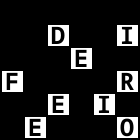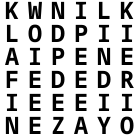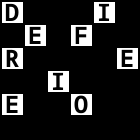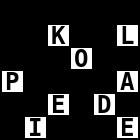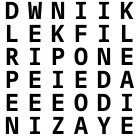Fleissner stencil
The Fleißner template , also Fleißner table , is an encryption process in which the plain text of a message is scrambled into a ciphertext by transposition using a template . The Fleißner template was named after the Austrian Colonel Eduard Fleißner von Wostrowitz . This had published the procedure in 1881 in his treatise New Cartridge Secret Writing. The French writer Jules Verne described the encryption process with the Fleissner template in his novel Mathias Sandorf in 1885 .
The procedure
The Fleißner stencil consists of a cardboard square from which several smaller squares have been cut out. The template is placed on a sheet of paper and one letter of the plain text is entered in a cut out square. Then the template is rotated ninety degrees and the following letters are entered into the gaps. The whole thing is done four times, creating a square with scrambled letters. If the message is longer, a new square is started. If it is shorter, the remaining gaps are filled with randomly chosen letters.
example
The text WIKIPEDIA DIE FREE ONLINE ENZYKLOPAEDIE should be encrypted.
Turning clockwise (clockwise) results in the following scheme:
Turning to the left (counterclockwise) results in the following scheme:
Mathematical basics
Conditions for creating such templates are:
- The number of total fields can be divided by 4 (the template is applied four times)
- A quarter of the fields is cut out
- No symmetry (common template fields) within the cut-out fields when rotated by 90 degrees
In the specific case, the template has 36 fields, 9 of which have been cut out.
The templates can be generated by filling a quarter of the matrix with the values 1 to 4, for example, and rotating it three times by 90 ° into the next quadrant while shifting the numbers ( ) cyclically . All fields with the same number are cut out, e.g. B. the 1.
Another possibility for creating a Fleißner template is to fill a quarter of the template with the values 1 to 9 and then turn it three times by 90 ° for the other quadrants. Then each value is cut out exactly once.
The second possibility provides a fairly simple derivation of the number of different possibilities:
If you want to cut out the number one, you have four options to choose from. You also have four options for cutting out all other digits. This results in:
More generally, the formula applies to a size stencil
for the number of possibilities .
So there are 262,144 possible templates, not all of which are suitable for good encryption, as fields are often next to each other and the text is therefore more readable.
If one assumes an even distribution over all four quadrants, the number of possible templates results from the distribution of the 4 digits to a quarter (rounded up) of the remaining fields multiplied by :
The following formula can be used for stencils of any size with even distribution:
with as number of fields.
literature
- Rudolf Kippenhahn : Encrypted messages. The secret script of Julius Caesar - Secret scripts in World War I and II - The Pope's code book - Enigma. 4th edition. Nikol, Hamburg 2006, ISBN 3-937872-37-X .
- Jules Verne : Mathias Sandorf .
Web links
- Online tool for encryption and decryption by Daniel Marschall
- Encryption with variable template size by Stefan Kalscheuer
Individual evidence
- ↑ A new highlight in the Mathematikum Gießen presents the replica of the ENIGMA encryption machine. Retrieved June 7, 2020 .
- ↑ Connette, Sebastian: Secret scripts in the elementary level with special consideration of the genetic principle, scientific housework, Pädagogische Hochschule Karlsruhe, 2009, retrieved from https://web.archive.org/web/20160221222804/http://www.ziegenbalg.ph -karlsruhe.de/material-homepage-jzbg/cc-interaktiv/pdf/Wwissenschaftliche-Hausarbeit-Connette-w.pdf (2020-06-07)


